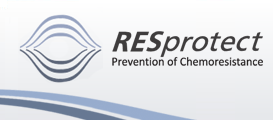| Inhibition of Induced Chemoresistance by Cotreatment with BVDU |

|

|

|
Page 11 of 12
DiscussionOur results indicated that BVDU cotreatment enhanced chemosensitivity. This might have been because of: (a) inhibition of oncogenic and DNA repair-associated enzymes; (b) induction of NQO1 activity; (c) suppression of chemotherapy-induced Mdr1 or Dhfr gene amplification; or (d) inhibition of the overexpression of survival pathways and reduced expression of ATP-generating enzymes in the recovery phase. Three rat tumor models gave evidence that BVDU cotreatment contributed significantly to tumor regression in vivo. DDX1, which was down-regulated by BVDU alone, seems to be of special importance. DDX1 is coamplified with MYCN and overexpressed in a subset of neuroblastoma and retinoblastoma cell lines/tumors (20,21) . Preliminary studies have shown that neuroblastoma patients with amplification of both DDX1 and MYCN have a worse prognosis than patients with only the MYCN gene amplified (21). Thus, DDX1 seems to have oncogenic potential, and it is predicted to function by RNA binding and modulation of RNA secondary structure.
Of the five genes affected by BVDU cotreatment with MMC, two are linked to DNA repair. BVDU reduced the expression of UBE2N and APEX to Apurinic sites result from treatment with cytostatic drugs. The resulting abasic sites can block the progress of the DNA replication apparatus. These sites must be corrected to restore genetic integrity. Silencing of APEX expression by RNA interference nearly doubled specific cell lysis, showing enhanced DNA nicking (24). BVDU induced NQO1. This is in accordance with the observation that a multifactorial multidrug resistance phenotype of tumor cells involves a decrease and not an increase in NQO1 expression (9) . NQO1 enzyme activity was enhanced in response to BVDU combinatorial treatment with DOX or MXA, respectively. Hence, it can be speculated that enforced NQO1-mediated bioactivation of DOX and MXA could increase the cytotoxic potential of these drugs. On the other hand, MMC, its effects being strongest depending on NQO1 enzyme activity, showed no enhancement of NQO1 activity. Therefore, the sensitizing effect of BVDU does not seem to be implicitly NQO1-dependent. Many of the drugs used in anticancer therapy, such as DOX and MXA (25), perturb the redox state and the mitochondrial respiration of the target cancer cell, which leads to the production of ROS. However, a subsequent burst of ROS will indiscriminately affect not only tumor cells but also normal tissue, which causes unwanted systemic side effects during therapy. NQO1 is a scavenger of ROS, and that way, induced NQO1 activity can protect cells from nonspecific ROS and electrophile attack (26). This may explain the improved therapeutic outcome against experimental tumors in vivo with no systemic toxicity and gain of body weight in response to BVDU cotreatment, as was observed in our animal models. The first direct evidence that in some tumor cells overexpression of genes because of amplification gives cells a selective advantage in the presence of a cytostatic drug derives from analysis of tumor cells taken from patients treated with MTX, an inhibitor of the enzyme DHFR (1). Resistance to MTX in human tumors has in many cases been shown to be associated with amplification of the gene encoding DHFR (27) . Furthermore, expression of the DHFR gene has been implicated in resistance to a variety of chemotherapeutic agents and has been detected in human ovarian and colon tumors (28). In our experiments, treatment with DOX for 50 days caused Mdr1 gene amplification and overexpression in DMBA-induced rat tumors. Cotreatment with BVDU inhibited this cytostatic drug-induced effect. Beyond that, Dhfr gene amplification was inhibited in 3T6 mouse cells. A comprehensive effect of BVDU was observed in the recovery phase. Gene products linked to survival, microfilament formation, differentiation, signal transduction, and ATP generation were affected. BVDU inhibited survival pathways and enforced apoptotic response. BVDU cotreatment might have promoted apoptosis by blocking an antiapoptotic survival pathway involving STAT3 and JUN-D. Additional mechanisms are quite likely, but still under investigation.
Constitutively activated STAT3 is oncogenic (7) and contributes to the development of various human cancers (29)
by inhibiting apoptosis (30). Thus, STAT3 promotes cell survival and renders cancer cells resistant to chemotherapy. Accordingly, the inhibition of STAT3-signaling induces apoptosis specifically in tumor cells, and increases sensitivity to chemotherapeutic agents (7). Along this line, it was demonstrated that dominant-negative Stat3-expression sensitizes melanoma cells to FAS-L-induced apoptosis (30). Therefore, STAT3-signaling in human tumors has been proposed as a novel molecular target for therapeutic intervention to reduce resistance of tumor cells to apoptosis (29). JUN-D is an essential and ubiquitously expressed component of the activating protein-1 transcription factor complex. Jun-D(-/-) primary fibroblasts exhibit premature senescence and increased sensitivity to p53-dependent apoptosis on UV-irradiation or tumor necrosis factor
 treatment (8), which suggests that JUN-D may activate the nuclear factor treatment (8), which suggests that JUN-D may activate the nuclear factor  B survival pathway. Moreover, p202, which is directly regulated by JUN-D, renders fibroblasts more refractory to apoptosis (31). In support of this reasoning, we demonstrated that BVDU cotreatment down-regulated the STAT3 and JUN-D survival pathways, thereby limiting chemoresistance. B survival pathway. Moreover, p202, which is directly regulated by JUN-D, renders fibroblasts more refractory to apoptosis (31). In support of this reasoning, we demonstrated that BVDU cotreatment down-regulated the STAT3 and JUN-D survival pathways, thereby limiting chemoresistance.
|
||||||||||||||



 30% of control level. The UBE2N gene encodes a ubiquitin-conjugating enzyme, which is thought to be involved in protein degradation. The protein complex containing UBE2N seems to be involved in the assembly of novel polyubiquitin chains for signaling in DNA repair and, through differential ubiquination of PCNA, affects resistance to DNA damage (22,23)
30% of control level. The UBE2N gene encodes a ubiquitin-conjugating enzyme, which is thought to be involved in protein degradation. The protein complex containing UBE2N seems to be involved in the assembly of novel polyubiquitin chains for signaling in DNA repair and, through differential ubiquination of PCNA, affects resistance to DNA damage (22,23)